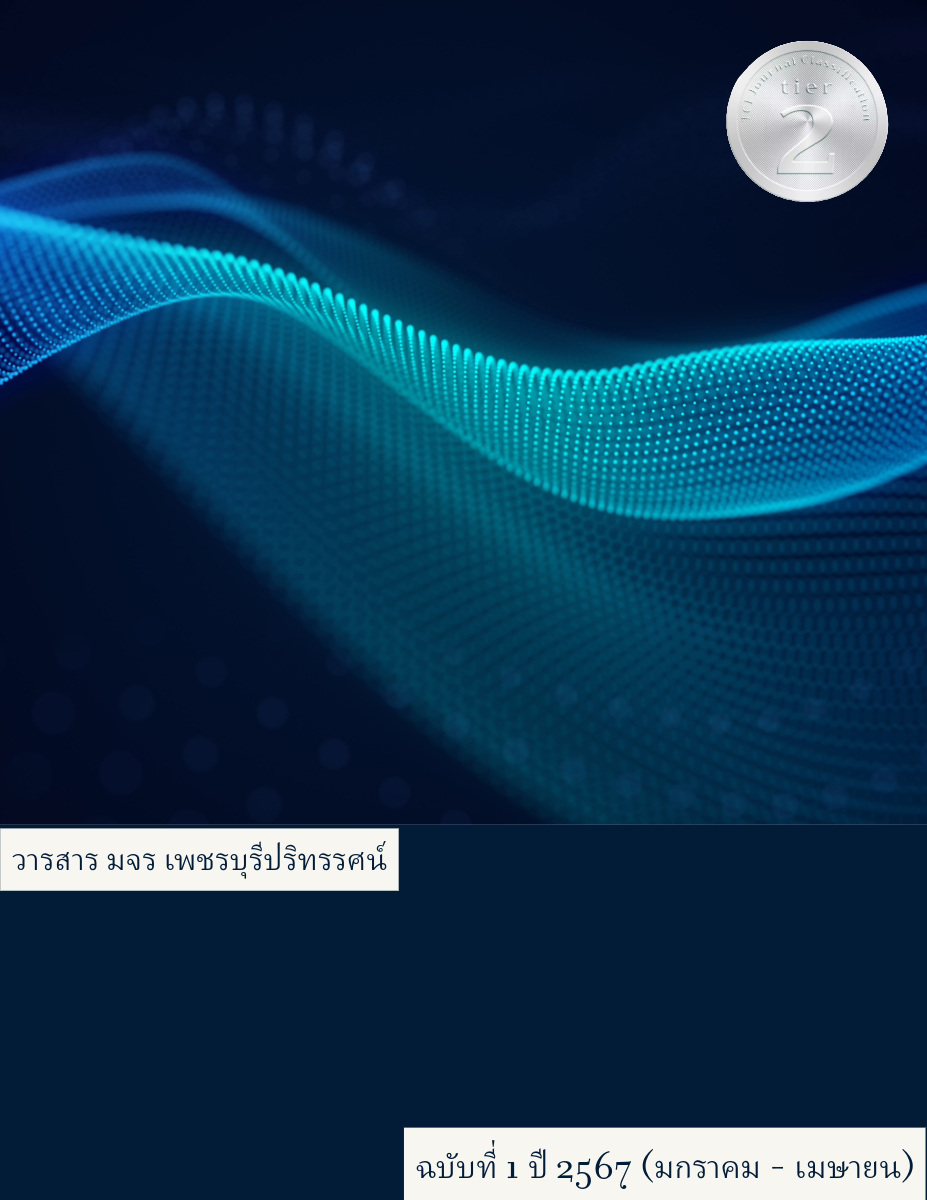The Development of the Solid Waste Management Model with Participation of Local Government Organizations and Communities in Wiangkalong Subdistrict, Chiang Rai Province
Main Article Content
Abstract
This study aimed to (1) explore the solid waste management information of the communities, and (2) develop a solid waste management model with the participation of local government organizations (LGOs) and communities in Wiang Ka Long subdistrict, Wiang Pa Pao district, Chiang Rai province.
The action research involved collecting data/information on the solid waste management of communities in the subdistrict from a sample of 400 household representatives, and developing the solid waste management model in a workshop, with the collected information as input, for a sample of 40 LGO officials and community representatives. The collected data were analyzed using descriptive statistics, frequencies, percentages, means and standard deviations. The tools used in the research were (1) a questionnaire on solid waste management of communities and (2) a satisfaction assessment form before/after developing and using the solid waste management model. The content of the questionnaire was verified by three experts and its accuracy was between 0.71 and 0.91.
The results showed that: (1) The people separated the solid waste before throwing it away and of all the waste generated in a week, 33% was organic waste, 33% was recyclable waste, 17% was general waste, and 17% was hazardous waste. The waste was separated as salable and non-salable waste, and the latter was incinerated. Among all respondents, their levels of knowledge, attitudes and behaviors on waste reduction were high at 93.7%, 74.7% and 76.8%, respectively. (2) Based on the newly developed solid waste management model with LGO and community participation, four types of waste management were specified: (i) wet garbage was used for making compost or animal feed; (ii) recyclable waste was to be collected for sale or donation; the proceeds were used for supporting dependent people in the community; (iii) hazardous waste was collected at the village’s waste separation site for further proper disposal; and (iv) general waste was to be taken for disposal at a landfill or burning in a household incinerator. In this regard, local municipalities, community leaders and citizens had been encouraged participate and play a role in the solid waste management activities. Based on the satisfaction assessment of the participants, before and after the use of the model, the highest level of satisfaction increased from 3.33% to 42.8%. However, they have suggested that local regulations should be issued in line with the developed solid waste management model, periodic evaluations should jointly conducted on the operations of the model, and a further study should be carried out to explore the achievements or success factors of the model.
Article Details

This work is licensed under a Creative Commons Attribution-NonCommercial-NoDerivatives 4.0 International License.
References
กรมควบคุมมลพิษ.(2559).คู่มือประชาชน การคัดแยกขยะมูลฝอยอย่างถูกวิธีและเพิ่มมูลค่า.พิมพ์ครั้งที่ 8 กรุงเทพมหานคร: บริษัท ฮีซ์ จำกัด.
กรมควบคุมมลพิษ.(2563).รายงานสถานการณ์มลพิษของประเทศไทย ปี 2562.พิมพ์ครั้งที่ 1 กรุงเทพมหานคร: บริษัท สไตล์ครีเอทีฟเฮ้าส์ จำกัด.
กรมอนามัย.(2553).คู่มือการประเมินผลกระทบต่อสุขภาพ กรณีการจัดการขยะมูลฝอยสำหรับองค์กรปกครองส่วนท้องถิ่น.กองประเมินผลกระทบต่อสุขภาพ กรมอนามัย กระทรวงสาธารณสุข.
โครงการพัฒนาและส่งเสริมความร่วมมือเครือข่ายนักวิจัยสิ่งแวดล้อม.(ม.ป.ป.).การบริหารจัดการขยะและเทคโนโลยีที่เหมาะสมโดยการมีส่วนร่วมของชุมชน: กรณีศึกษา อบต.ไร่ส้ม จ.เพชรบูรณ์.สืบค้น 2พฤศจิกายน 2564, สืบค้นจากhttp://203.157.181.2/sculpt/attach.
ฉัตรนภา สนองบุญ.(2564).ผลของโปรแกรมสร้างแรงจูงใจต่อความรู้เรื่อง 5R และพฤติกรรมในการลดขยะมูลฝอยครัวเรือนของประชาชนตำบลเมืองบางขลัง อำเภอสวรรคโลก จังหวัดสุโขทัย. วารสารความปลอดภัยและสุขภาพ มหาวิทยาลัยสุโขทัยธรรมาธิราช,14(2),61-73.
ทิวา ประสุวรรณ,ศิริวัฒน์ จิระเดชประไพ,และคณะ.(2559).การจัดการขยะแบบมีส่วนร่วมขององค์กรปกครองส่วนท้องถิ่นและชุมชนในตำบลบ้านแลง อำเภอเมืองระยอง จังหวัดระยอง. (ดุษฎีนิพนธ์ ดุษฎีบัณฑิต วารสารวิจัยและพัฒนาวไลยอลงกรณ์ ในพระบรมราชูปถัมภ์). มหาวิทยาลัยราชภัฏราชนครินทร์,ปทุมธานี.
ธํารงค์ เรืองโสภณ,วรรณี เรืองโสภณ,งเพ็ญพร พุ่มกุมาร และคณะ.(2560).การบริหารจัดการขยะและเทคโนโลยีที่เหมาะสมโดยการมีส่วนร่วมของชุมชน.(รายงานการวิจัย ไม่ได้ตีพิมพ์).ศูนย์วิจัย และฝึกอบรมด้านสิ่งแวดล้อม กรมส่งเสริมคุณภาพสิ่งแวดล้อม,กรุงเทพมหานคร.
ประชาสรรณ์ แสนภักดี .M.P.H.CMU.(2004) เทคนิคกระบวนการวางแผนแบบมีส่วนร่วม Mind Map® & AIC for Participatory Planning .สืบค้นเมื่อ 1 พฤศจิกายน 2564, สืบค้นจาก http://www.prachasan.com.
นงกต สวัสดิชิตัง,กฤตติกา แสนโภชน์,และคณะ.(2558).การพัฒนารูปแบบการจัดการขยะมูลฝอยของชุมชนในเขตเทศบาลนครอุดรธานี.วารสารบัณฑิตศึกษา มนุษยศาสตร์ สังคมศาสตร์ มหาวิทยาลัยราชภัฏอุดรธานี,3(1),47-64.
นนทชา มานะวิสาร.(2564).การพัฒนารูปแบบการจัดการขยะโดยการมีส่วนร่วมของชุมชนและภาคีเครือข่ายตำบลศรีษะเกษ อำเภอนาน้อย จังหวัดน่าน.วารสารวิจัยสาธารณสุขน่าน,3(1),1-13.
พรทิพย์ เกยุรานนท์ รศ.ดร. (2564). แนวคิดเกี่ยวกับการวิจัยเชิงปฏิบัติการ หน่วยที่ 7 การวิจัยในอนาคตการวิจัยเชิงปฏิบัติการ การวิเคราะห์เชิงอภิมาณ ชุดวิชา 50703 สถิติและการวิจัยในการจัดการสุขภาพ.พิมพ์ครั้งที่ 4. นนทบุรี: สำนักพิมพ์ มหาวิทยาลัยสุโขทัยธรรมาธิราช.
พิชญามญชุ์ แขวงเมือง,วิทยา เจริญศิริ และ ยุภาพร ยุภาศ.(2560).การจัดการขยะมูลฝอยครัวเรือนของประชาชนในเขตพื้นที่ตำบลวังแสง อำเภอแกดำ จังหวัดมหาสารคาม.วารสารการประชุมวิชาการระดับชาติด้านการบริหารกิจการสาธารณะยุคดิจิทัล, มปป(5),683-693.
ระบบสารสนเทศด้านการจัดการขยะมูลฝอยขององค์กรปกครองส่วนท้องถิ่น. (2565, 16 กุมภาพันธ์). ข้อมูลขยะมูลฝอยขององค์กรปกครองส่วนท้องถิ่น (มฝ.2). สืบค้นจากhttp://waste.dla.go.th.
วัชรินทร์ อินทพรหม.(2557).รูปแบบการมีส่วนร่วมในการพัฒนาท้องถิ่นของประชาชน. วารสารบัณฑิตศึกษามหาวิทยาลัยราชภัฏวไลยอลงกรณ์ ในพระบรมราชูปถัมภ์,8(3),278-289.
วชิราภรณ์ ขุนจันทร์ และคณะ.(2557).โครงการกลยุทธ์การจัดการขยะอย่างมีส่วนร่วมในเทศบาลเมืองเขารูปช้าง.(รายงานการวิจัย ไม่ได้ตีพิมพ์).สำนักงานกองทุนสนับสนุนการวิจัย, กรุงเทพมหานคร.
ศราวุฒิ ทับผดุง.(2563). ปัจจัยที่มีผลต่อพฤติกรรมการลดปริมาณขยะมูลฝอยครัวเรือนในเขตองค์การบริหารส่วนตำบลที่ไม่มีการบริหารจัดการขยะมูลฝอยอำเภอเมือง จังหวัดพิษณุโลก (วิทยานิพนธ์ปริญญามหาบัณฑิต ไม่ได้ตีพิมพ์). มหาวิทยาลัยนเรศวร, พิษณุโลก.
สิตศรรษ์ วงษ์อนันต์ พย.บ.1, พัชรี ใจการุณ ปร.ด. และคณะ.(2561). การศึกษาการจัดการขยะมูลฝอยของประชาชนในหมู่ 10 ตำบลขามใหญ่ อ.เมือง จ.อุบลราชธานี (วารสารวิทยาศาสตร์สุขภาพ วิทยาลัยพยาบาลบรมราชชนนี สรรพสิทธิประสงค์ ปีที่ 2 ฉบับที่ 3). วิทยาลัยพยาบาลบรมราชชนนี สรรพสิทธิประสงค์, อุบลราชธานี.
สำนักบริหารการทะเบียน กรมการปกครอง. (2565, 20 มกราคม). สถิติประชากรทางทะเบียนราษฎร (รายเดือน). สืบค้นจาก https://stat.bora.dopa.go.th
สำนักงานส่งเสริมการปกครองท้องถิ่นจังหวัดเชียงราย. (2565). แผนปฏิบัติการการจัดการขยะมูลฝอยชุมชน “จังหวัดสะอาด”ประจำปีงบประมาณ พ.ศ.2566
สำนักงานสิ่งแวดล้อมภาคที่ 2 ลำปาง กรมควบคุมมลพิษ.(2564).คู่มือสำหรับองค์กรปกครองส่วนท้องถิ่น การจัดการขยะมูลฝอยชุมชนอย่างครบวงจร.พิมพ์ครั้งที่ 1. ลำปาง : ส่วนส่งเสริมการจัดการสิ่งแวดล้อม.
อภิชิต กองเงิน.(2564). การพัฒนารูปแบบการจัดการขยะมูลฝอยโดยการมีส่วนร่วมของชุมชนตําบลน้ำชุน อำเภอหล่มสัก จังหวัดเพชรบูรณ์.วารสารวิจัยการพยาบาลและการสาธารณสุข, 1(1),55-64.
อภิศักดิ์ ธีระวิสิษฐ์ รศ.ดร., (2560). เทคนิคและเครื่องมือสื่อความคิดในการศึกษาชุมชน. กรุงเทพ.มูลนิธิมั่นพัฒนาสำนักงานกองทุนสนับสนุนการวิจัย (สกว.).สืบค้นจาก http://www.tsdf.nida.ac.th/elctfl/articlefile. (วันที่สืบค้น 1 พฤศจิกายน 2564)
อรทัย ก๊กผล. (2552). คู่คิด คู่มือ การมีส่วนร่วมของประชาชนสำหรับผู้บริหารท้องถิ่น.สถาบันพระปกเกล้า (พิมพ์ครั้งที่ 1). ส เจริญ การพิมพ์.
Ali, N. E. H., & Siong, H. C. (2016). Social factors influencing household solid waste minimization. In 4th International Building Control Conference, IBCC 2016, 7 March 2016 through 8 March 2016, Kuala Lumpur; Malaysia.
Best, J. W. (1977). Research in education. New Jersey: Prentice Hall.
Bloom, B. (1971). Handbook on formative and summative evaluation of student learning. New York: McGraw-Hill
Dhokhikah, Y., Trihadiningrum, Y., & Sunaryo, S. (2015). Community participation in household solid waste reduction in Surabaya, Indonesia. Resources, Conservation and Recycling, 102, 153-162.
Rovinelli, R. J., & Hambleton, R. K. (1977). One the use of content specialists in the assessment of criterior-referenced test item validity (vol. 2). Dutch Journal for Educational Research. 2, 49-60

